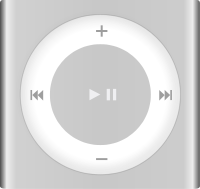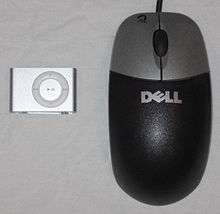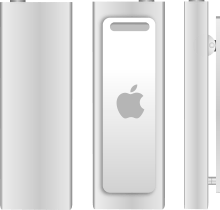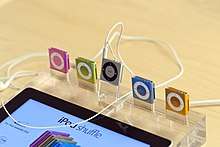iPod Shuffle
The iPod Shuffle (stylized and marketed as iPod shuffle) is a digital audio player designed and formerly marketed by Apple Inc. It was the smallest model in Apple's iPod family, and was the first iPod to use flash memory. The first model was announced at the Macworld Conference & Expo on January 11, 2005; the fourth- and final-generation models were introduced on September 1, 2010.[2] The iPod Shuffle was discontinued by Apple on July 27, 2017.[3]
 iPod Shuffle 4th generation in Silver | |
| Manufacturer | Apple Inc. |
|---|---|
| Product family | iPod |
| Type | Digital audio player |
| Lifespan | January 11, 2005 – July 27, 2017 (12 years, 6 months) |
| Discontinued | July 27, 2017[1] |
| Media | Flash memory 512 MB to 4 GB |
| Operating system | 1.1.5 (1G) 1.0.4 (2G) 1.1 (3G) 1.0.3 (4G) |
| Display | None |
| Input | Shuffle, Play In Order, Turn Off, 3.5-mm stereo headphone jack |
| Connectivity | USB 2.0 (1G Directly) |
| Power | Lithium-ion battery |
| Mass | 12.5 grams (0.44 oz) |
| Successor | iPhone iPod Touch |
| Related articles | iPod Nano iPod Mini iPod Classic iPod Touch iPhone |
| This article is part of a series on the |
| iPod |
|---|
| List of iPod models |
Overview

1st generation
Released on January 11, 2005 during the Macworld expo,[4] the first-generation iPod Shuffle weighed 0.78 ounces (22 g), and was designed to be easily loaded with a selection of songs and to play them in random order. According to Apple, owners of existing iPods had often left the music selection to "shuffle", and the new iPod Shuffle was a way of implementing that in a much more cost-effective fashion. It relied on the use of an "autofill" feature in iTunes, which selected songs at random from a user's music library (or from a specific playlist) and copied as many as would fit into the iPod Shuffle's storage. The first generation could hold up to 240 songs (1 GB model, based on Apple's estimate, of four minutes per song and 128 kbit/s AAC encoding). It used the SigmaTel STMP35xx system on a chip (SOC) and its software development kit (SDK) v2.6, a flash memory IC, and USB rechargeable lithium cell. The STMP35xx SOC and its software was the most fully integrated portable MP3 playback system at release time and SigmaTel was Austin's largest IPO (2003) capturing over 60% of flash based MP3 player world market share in 2004. In 2005, peak iPod first-generation Shuffle production occurred at a hundred thousand units per day, at the Asus factory.
It lacked a display, the trademark click wheel, playlist management features, and the games, address book, calendar, alarm, and notes capability of larger iPods; nor could it be used with iSync. Due to the codec not being ported, it was incapable of playing Apple Lossless and AIFF audio files.
Due to superior audio technology in the SigmaTel STMP35xx SOC and SDK, the first generation had a better bass response than a fourth-generation iPod, according to a review published days after its release.[5][6]

iTunes offered some new features for the iPod Shuffle. One was the ability to reduce the bit rate of songs to 128 kbit/s AAC. The conversion is done automatically, with the original file left untouched on the computer and the smaller (lower bit rate) file sent to the iPod Shuffle. Older versions of iTunes allowed an iPod Shuffle playlist to be viewed and changed while the unit is not connected; the next time the unit is connected, it can then be updated with the changed playlist. However, this functionality is no longer a part of iTunes as of iTunes 7.
The front of the iPod Shuffle had buttons for Play/Pause, Next Song/Fast Forward, Previous Song/Fast Reverse, and up and down volume adjustment. On the reverse, it had a battery level indicator light (activated by a button) and a three-position switch to turn the unit off or set it to play music in order or shuffled. It plugged directly into a computer's USB port (either 1.1 or 2.0), through which it also recharged its battery, which has an expected life of around 12 hours. The USB plug is hidden beneath a cap. The unit also comes with a lanyard that attaches to the iPod Shuffle via an attached cap which allows the iPod Shuffle to hang around the user's neck.
The first generation could also be used as a USB flash drive. iTunes allowed users to set how much of the drive would be allowed for storing files, and how much would be used for storing music.
2nd generation

On September 12, 2006, Apple announced the release of the second-generation iPod Shuffle, calling it "the most wearable iPod ever".[7] First shipments of the unit were slated for an October 2006 arrival, but actually started shipping on Friday, November 3, 2006.[8] The second generation initially featured a lone 1 GB model in a silver brushed aluminum case, similar to the second-generation iPod Nano and the older iPod Mini. The new model was less than half the size of the first-generation model at 41.2 x 27.3 x 10.5 mm (1.62 x 1.07 x 0.41 in), and was the size of the iPod Radio Remote. Apple claimed it was the "world's smallest MP3 player". This generation included the new built-in belt clip, and the actual unit itself was thinner, with the entire device weighing only 15.5 g (0.55 ounces). The power/shuffle/no shuffle switch from the first-generation version was separated into two controls to avoid an accidentally selected mode of operation. The formatting of the iPod itself was new to Apple, as the second-generation Shuffle only formatted itself to FAT32.
On the second-generation iPod Shuffle, USB connectivity is provided via an included piece of hardware which acts as a docking station for the transfer of data and the recharging of the iPod's internal battery through its headphone jack. The second-generation iPod Shuffle was also able to act as a flash drive, just like the first-generation iPod Shuffle. However, unlike the first-generation iPod Shuffle, the second generation did not have a built-in USB connector. This means that the docking station was required for connection to a computer.
The second-generation Shuffle could play MP3, MP3 VBR, AAC, Protected AAC, Audible (formats 2, 3 and 4), WAV and AIFF. Due to its low processing power, the only iTunes-supported file format that the iPod did not support is Apple Lossless.
On January 30, 2007, Apple announced the addition of four new colors to the iPod Shuffle line - pink, orange, green, and blue, in addition to the original silver color. The orange color was a first for the iPod franchise. They also now came with new redesigned headphones that were not included with the original silver model. The box was also changed to have gray text instead of the lime-green text. On September 5, 2007, Apple introduced four new colors, including a Product Red version. The new colors were turquoise, lavender, mint green, and Product Red, with the previous colors discontinued. On February 19, 2008, Apple introduced a 2 GB version of the iPod Shuffle, retailing for US$69 and available in all the same colours as the 1 GB model. At the Apple Let's Rock Event on September 9, 2008, Apple once again released four new colors for the iPod Shuffle: blue, green, pink, and red, replacing the colors that were released in September 2007. The new blue, green and pink variants of the iPod Shuffle reverted to shades that were similar to the colors that were released in January 2007.[9] In June 2009, Avon offered a gold iPod Shuffle (second generation) for $29 when purchased in conjunction with two ANEW skin care products.[10]
The second generation 2 GB iPod Shuffle was discontinued on March 11, 2009, and the 1 GB version was discontinued on September 9, 2009.
3rd generation

The third-generation iPod Shuffle was released on March 11, 2009 and was said by Apple to be "jaw-droppingly small" and "The first music player that talks to you".[11] with dimensions of 45.2 mm × 17.5 mm × 7.8 mm (1.8 in × 0.7 in × 0.3 in). It was available with a silver or black brushed aluminum case similar to the second generation iPod Shuffle; this made it the first iPod Shuffle that was available in black. It featured VoiceOver technology that allowed song names, artist names, album names and playlist contents and names to be spoken in 20 different languages[12] using the Text-to-Speech incorporated in iTunes 8 and 9. It also gained support for multiple playlists, in contrast to previous versions of the iPod Shuffle, which allowed only a single playlist.
The third-generation iPod Shuffle featured a polished steel attachment clip, adopting for the first time the polished steel finishing previously found only on the larger iPods, rather than the brushed aluminum used in the second-generation iPod Shuffle. It also no longer had volume or track controls on the device itself. Instead, the packaged iPod earbuds included a three-button device on the right earbud cord. This added the functions of changing between playlists, hearing the song title and artist of the track playing, as well as play/pause, track changes and volume control.[13] It originally was not possible to change songs or volume with most third-party headphones, since they lacked these controls. However, since the device began playing music automatically when it was turned on, third-party headphones could still be used in "autoplay" mode (with no volume or playback controls), and after its release, some third-party headphones and headphone adapters began to include full support for the third generation.[14] The official headphones contained a chip designed by Apple to control the device. DRM is not however present in the chip as there is no encryption used.[15]
According to the compatibility list published in Apple's website,[16] none of the currently sold Apple headphones support the third-generation iPod shuffle.
On September 9, 2009, Apple introduced three new colors for the iPod Shuffle: pink, blue, and green. The Apple Store also offered a 4 GB model made of polished stainless steel.[17]
4th generation

On August 27, 2010, Apple won a patent for a “Very small form factor consumer electronic product”[18], which describes the parts and processes that go into making the ultra-portable music player, the iPod shuffle.[19]
On September 1, 2010 the fourth and final generation was released[20] as part of the new iPod lineup. The fourth generation features the return of clickable track and volume controls from the first two generations. The control pad is 18% larger than the second generation of iPod Shuffle, and the dimensions of the device are 29 mm × 31.6 mm × 8.7 mm (1.1 in × 1.2 in × 0.3 in) and it weighs 12.5 g (0.4 oz).
The model also features VoiceOver from the third generation, now with a devoted physical button, in twenty-nine languages (Chinese, Czech, Danish, Dutch, English, Finnish, French, German, Greek, Hungarian, Italian, Japanese, Korean, Norwegian, Polish, Portuguese, Romanian, Russian, Slovak, Spanish, Swedish, Thai, and Turkish). It also features Genius, and can handle multiple playlists. Like the previous generation it supports MP3, VBR, AAC, Protected AAC, Audible (formats 2, 3 and 4), WAV, AIFF and Apple Lossless, and its battery lasts for 15 hours of music, according to Apple.
It was originally sold in five colors (silver with a black control pad, green, blue, orange and pink with a white control pad). However, on September 12, 2012, Apple held an event to formally introduce the iPhone 5, as well as a new iPod lineup, and the iPod Shuffle remained unchanged except for seven new color options (silver or black with a black control pad or green, blue, pink, yellow, and purple with a white control pad), as well as a Product Red edition model with a white control pad. Unlike the second generation, the iPod does not come with a dock, but like the third generation, comes with a 45 mm USB Cable. The included in-box headphones do not feature the remote control, but the device supports them.
On September 10, 2013, to coincide with the release of the iPhone 5S, the "Slate" color option was replaced with "Space Grey".
On July 15, 2015, Apple released 6 new colors (blue, pink, silver, gold, space grey, and Product Red) for the iPod Shuffle.
On July 27, 2017, The iPod shuffle, along with the iPod Nano, was discontinued.
Models
| Generation | Image | Capacity | Colors | Connection | Original release date | Minimum OS to sync | Rated battery life (hours) |
|---|---|---|---|---|---|---|---|
| 1st |  |
512 MB | White | USB 2.0 (no adapter required) |
January 11, 2005 | Mac: 10.2.8 Windows: 2000 |
audio: 12 |
| 1 GB | |||||||
| New entry-level model. Uses flash memory and has no screen. It was discontinued on September 12, 2006. | |||||||
| 2nd | 1 GB | Silver | USB 2.0 (with included dock) |
September 12, 2006 | Mac: 10.3.9 Windows: 2000 |
audio: 12 | |
| 1 GB | Silver Blue Green Orange Pink |
January 30, 2007 | Mac: 10.3.9 Windows: 2000 | ||||
| 1 GB | Silver
Gold |
September 5, 2007 | Mac: 10.4.8 Windows: 2000 | ||||
| 2 GB | February 19, 2008 | ||||||
| 1 GB | Silver Blue Green Pink Product Red special edition |
September 9, 2008 | Mac: 10.4.10 Windows: 2000 | ||||
| 2 GB | |||||||
| Smaller clip design with anodized aluminum casing. The 1st model was discontinued on January 30, 2007. The 2nd model was discontinued on September 5, 2007. The 3rd model was discontinued on February 18, 2008. The 4th model reached the end of its production on March 11, 2009. | |||||||
| 3rd |  |
4 GB | Silver Black |
USB 2.0 (cable is included) |
March 11, 2009 | Mac: 10.4.11 Windows: XP |
audio: 10 |
| 2 GB | Silver Black Blue Green Pink |
September 9, 2009 | Mac: 10.4.11 Windows: XP | ||||
| 4 GB | Silver Black Blue Green Pink Polished Stainless Steel (exclusive to Apple Online and retail stores) | ||||||
| Smaller design with controls relocated to right earbud cable, features playlists and VoiceOver. The 4 GB model was discontinued on September 9, 2009. The 2GB model was discontinued on September 1, 2010. | |||||||
| 4th |  |
2 GB | Silver Blue Green Orange Pink |
USB 2.0 (cable is included) |
September 1, 2010 | Mac: 10.5.8 Windows: XP |
audio: 15 |
| Silver Black Blue Green Pink Purple Yellow Product Red special edition |
September 12, 2012 | Mac: 10.6.8 Windows: XP (SP3) | |||||
| Silver Blue Gold Pink Space Grey Product Red Special Edition |
July 15, 2015 | Mac: 10.8.5 Windows: 7 | |||||
| Redesign returning the play/track/volume buttons from the second generation and power/shuffle mode switch from the 1st gen, and adding a button for VoiceOver. The silver, blue, green, orange and pink models were discontinued on September 12, 2012. Apple replaced them with new silver, slate, purple, pink, yellow, green and blue models, all with matte finish, rather than a glossy finish, in order to correspond with the 5th-generation iPod touch and 7th-generation iPod nano. New "Space Gray" color option replaces "Slate" as of September 10, 2013, in order to correspond with the iPhone 5S. Discontinued on July 27, 2017. | |||||||
Reception and impact
The iPod Shuffle was announced at the same time as the Mac Mini. Like the iPod Shuffle, the Mac Mini is a scaled-down product which has been introduced at a lower price. These two products together can be seen as a conscious effort on the part of Apple management to target a lower-end market and increase visibility in the mass-market. Previously, the success of Apple's iPod and especially the iPod Mini had been chipping away at the inexpensive flash player market, causing flash players at the beginning of 2005 to account for less than half the market share they did in 2004. However, the original and Mini iPods were expensive and the Shuffle was intended to make the iPod compete with mainstream players.
By April 2005, the end of Apple's second fiscal quarter, the iPod Shuffle had already proven itself to be a successful product for its manufacturer. Although Apple has chosen not to specify how many iPod Shuffles were sold in the product's first three months of existence, analysts at Piper Jaffray estimated that 1.8 million of the 5.3 million iPods sold in the second quarter were Shuffles. NPD Group estimates that the iPod Shuffle captured 43% of the flash-based music player market in February 2005, after only its second month of existence.[21] By March 2005 the iPod Shuffle's market share had risen to 58%.[22]
In September 2006, Apple CEO Steve Jobs announced during his keynote presentation on the "It's Showtime" Special Event, that until then, Apple had sold 10 million first-generation iPod Shuffles.
Problems
Blinking light problem
PC World reported a problem with the first-generation iPod Shuffles ceasing normal function, only to flash orange and green lights and become unmountable. Since the Shuffle has no display, the owner cannot read an error message or troubleshoot easily, requiring diagnosis by Apple service personnel. Flashing green and orange lights on the iPod Shuffle indicate that a generic "error" has occurred, according to Apple's documentation.[23] If the device is still covered by warranty, Apple will replace it for free.[24] This problem has also occurred on second-generation iPod Shuffles.
On October 26, 2006, Apple released an iPod Shuffle Reset Utility that corrected this problem for some owners of first-generation iPod Shuffles.[25] Then, in March 2007, an updated iPod Reset Utility was released which can also address similar problems with second-generation iPod Shuffles.[26]
Third-generation headphone controls
Unlike most other portable audio players, the third-generation iPod Shuffle's controls are situated on the packaged headphones. The user is unable to control the device unless they use either Apple headphones designed for it, or third-party headphones or adapters that must be licensed by Apple. The third generation iPod Shuffle's headphones contain a proprietary integrated circuit.[27] Also, inline control adapters that were made by third-party companies for use with the iPhone are incompatible with the iPod Shuffle.[28]
Several months after the third-generation release, several third-party companies, including Belkin and Scosche, released adaptors which can be used to add the controls to standard headphones.[29]
Timeline of compact iPod models

References
- "Apple removes iPod nano and shuffle from website hinting at discontinuation". 9to5Mac. July 27, 2017. Retrieved July 27, 2017.
- June, Laura. "Apple announces redesigned iPod shuffle, brings the buttons back". Engadget. Engadget. Retrieved September 1, 2010.
- "Apple removes iPod nano and shuffle from website hinting at discontinuation". 9to5Mac. July 27, 2017. Retrieved July 27, 2017.
- "Apple Introduces iPod shuffle". Apple Press Release. January 11, 2005.
- Bill Machrone (January 20, 2005). "Apple iPod Shuffle". PC Magazine. PC Magazine. Archived from the original on January 23, 2005. Retrieved March 29, 2005.
- Bill Machrone (March 16, 2005). "Shuffle's Got a Secret". PC Magazine. PC Magazine. Retrieved July 27, 2010.
- "Apple Unveils the New iPod shuffle", Apple.com, September 12, 2006. Accessed April 2, 2006.
- Blompo.com
- Ilounge.com. Ilounge.com. Retrieved on July 5, 2011.
- http://forums.macrumors.com/showthread.php?t=707814
- iPod shuffle – Small Size". "Apple. Retrieved on July 5, 2011.
- iPod shuffle – With VoiceOver, iPod shuffle talks". "Apple. Retrieved on July 5, 2011.
- "Controlling the Third-Generation iPod Shuffle". About. About.com.
- "New iPod shuffle requires extra adapter for third-party headphones". Engadget. Engadget.
- "Manufacturer confirms chip: iPod headphones now have the Apple Tax; Update: Apple confirms no DRM, authentication, just licensing". BoingBoing. BoingBoing.
- "Compatibility of Apple wired headset models with iPhone, iPad, and iPod models".
- Apple.com. Apple.com. Retrieved on July 5, 2011.
- 8368643, Dabov, Teodor; Kyle Yeates & Anthony Montevirgen, "United States Patent: 8368643 - Very small form factor consumer electronic product", issued February 5, 2013
- Tuesday, Mikey Campbell; February 05; 2013; PT, 05:05 am. "Apple wins exhaustive fourth-generation iPod shuffle patent". AppleInsider. Retrieved February 18, 2020.CS1 maint: numeric names: authors list (link)
- "Apple releases redesigned iPod nano, shuffle". Macworld. Retrieved September 11, 2018.
- Appleinsider.com Archived April 22, 2005, at the Wayback Machine
- Shuffle captures 58 percent of flash players market, says Apple, ArsTechnica
- "Quick Reference Card". Archived from the original on January 13, 2005.
- Johnston, Stuart (June 22, 2006). "If Lights Blink on Your iPod Shuffle, It Could Be Bad News". PC World. Retrieved February 8, 2006.
- "About the iPod shuffle Reset Utility". Apple. Archived from the original on July 28, 2007.
- "About iPod Reset Utility". Apple Inc.
- "Third-party headphones do require Apple-supplied chip". arstechnica.
- "Old iPod/iPhone Adapters don't work in new Shuffle". Boing Boing. Boing Boing.
- Scosche.com. Scosche.com. Retrieved on July 5, 2011.
- Apple Inc., Apple press release library, Retrieved September 19, 2007.
- Mactracker (mactracker.ca), Apple Inc. model database, version as of July 26, 2007.
